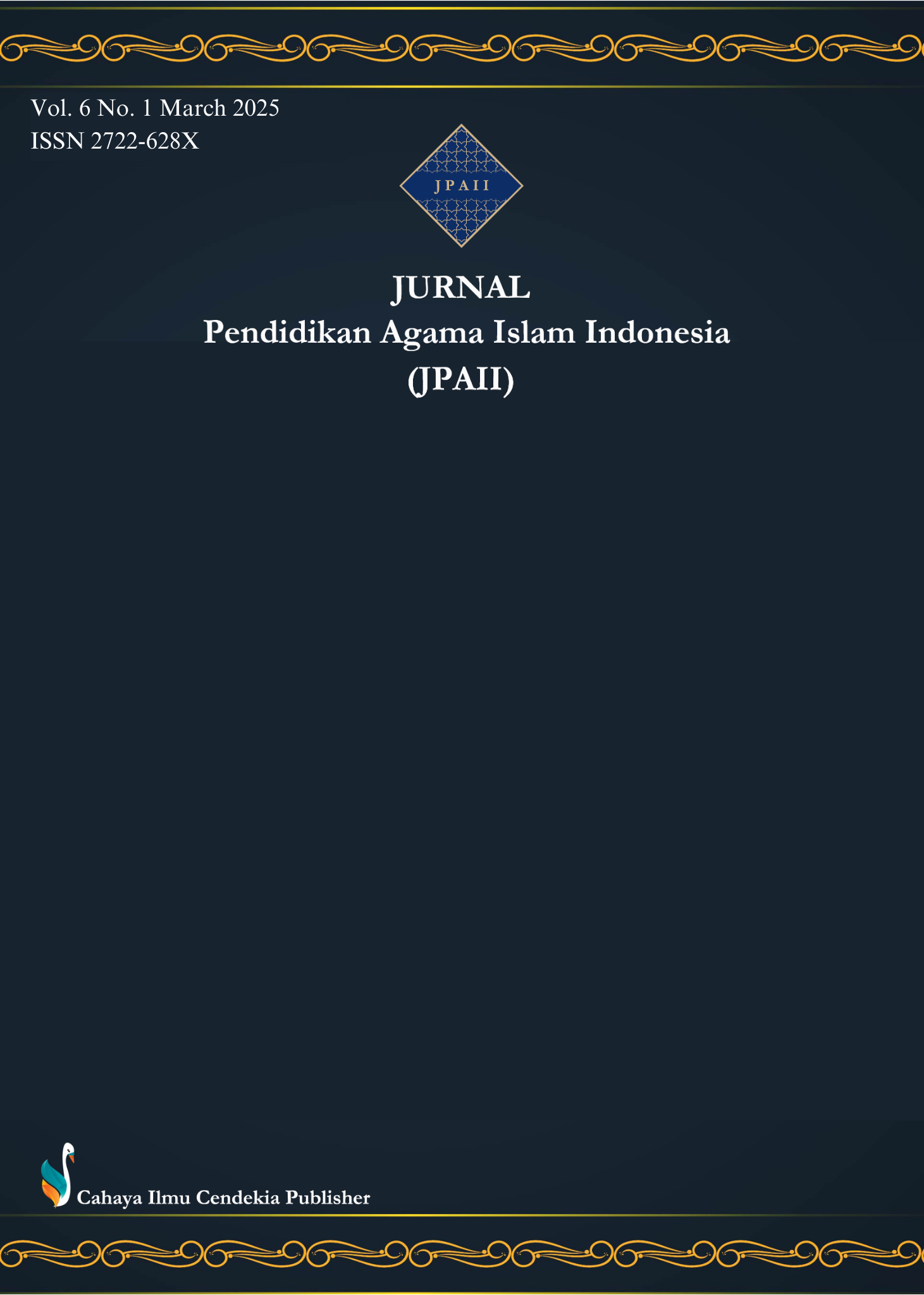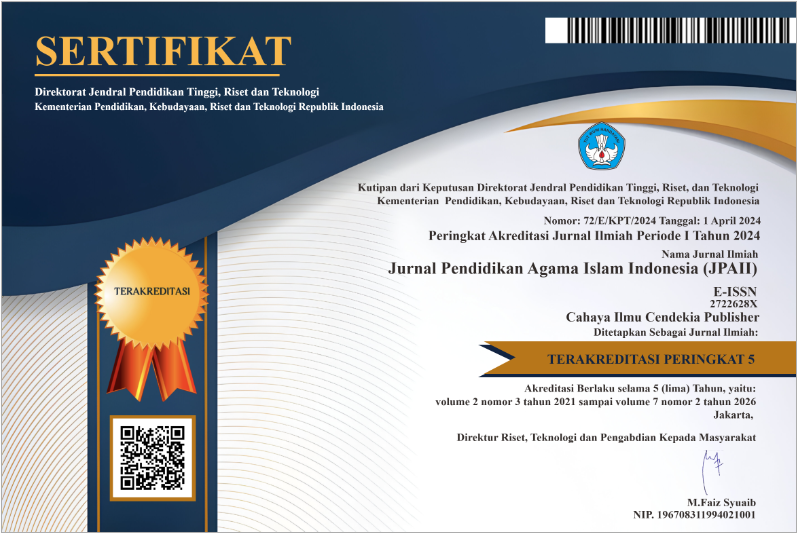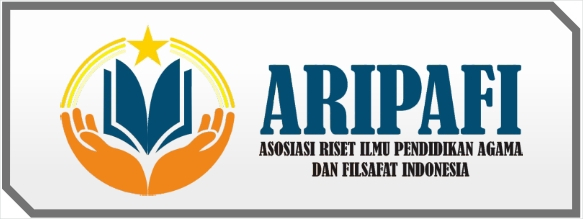Exploring the Role of Emotional Intelligence and Self-Confidence in Supporting Islamic Religious Education Learning Outcomes
Abstract
Purpose of the study: This study aims to investigate the effect of emotional intelligence (EI) and self-confidence on students' academic achievement in Islamic religious education, as well as evaluate the interaction between the two variables and provide strategic recommendations for educators to improve student learning outcomes.
Methodology: The method used in this research is quantitative with ex post facto design. The research sample consisted of 35 students of the Early Childhood Education Teacher Education (PG-PAUD) Study Program at STKIP Kumala Lampung. Data were collected through questionnaires measuring emotional intelligence (EI), self-confidence (SC), and student learning outcomes, and data were analyzed using ANOVA and paired-samples t-test.
Main Findings: The results showed a significant relationship between emotional intelligence (EI) and self-confidence (SC) on student learning outcomes. Students who have high levels of emotional intelligence and self-confidence tend to achieve better learning outcomes, with the average learning outcome reaching 78.90, compared to students who have low levels of emotional intelligence and self-confidence which only reach 66.95. This finding confirms the importance of emotional intelligence and self-confidence development in the context of Islamic religious education.
Novelty/Originality of this study: The uniqueness of this study lies in its focus on the influence of emotional intelligence (EI) and self-confidence (SC) in the context of Islamic religious education, which is still less explored in the literature. This research provides new insights that are useful for improving teaching strategies, supporting student development, as well as enriching existing knowledge in the field of Islamic religious education.
References
A. R. Carr, M. S. Samimi, P. Paholpak, E. E. Jimenez, and M. F. Mendez, “Emotional quotient in frontotemporal dementia vs. Alzheimer’s disease: the role of socioemotional agnosia,” Cogn Neuropsychiatry, vol. 22, no. 1, 2017, doi: 10.1080/13546805.2016.1259612.
M. Rafiei, “The effect of emotional quotient on organizational citizenship behavior in some Iranian hospitals,” Kybernetes, vol. 46, no. 7, 2017, doi: 10.1108/K-01-2017-0001.
T. Sharma and S. Singh, “Relationship of emotional intelligence with cultural intelligence and change readiness of Indian managers in the service sector,” Journal of Organizational Change Management, vol. 34, no. 7, 2021, doi: 10.1108/JOCM-05-2017-0193.
N. M. Hassan, N. Daud, N. N. R. N. Mahdi, M. S. Ibrahim, Y. M. Yusop, and M. F. Pauzi, “Modifiable factors influencing emotional intelligence among medical interns,” Future Healthc J, vol. 9, 2022, doi: 10.7861/fhj.9-2-s33.
D. E. Meisha and R. A. Al-dabbagh, “Self-confidence as a predictor of senior dental student academic success,” J Dent Educ, vol. 85, no. 9, 2021, doi: 10.1002/jdd.12617.
R. Karani and S. Desai, “May I know my EQ? Factors to automate EQ prediction using technology,” Pers Individ Dif, vol. 218, 2024, doi: 10.1016/j.paid.2023.112469.
H. Yusrida and T. Kurniawati, “Pengaruh Kecerdasan Emosional dan Komunikasi Interpersonal Terhadap Hasil Belajar Siswa pada Mata Pelajaran Pengelolaan Bisnis Ritel,” Jurnal Ecogen, vol. 4, no. 1, 2021, doi: 10.24036/jmpe.v4i1.11036.
K. Kustyarini, “Self efficacy and emotional quotient in mediating active learning effect on students’ learning outcome,” International Journal of Instruction, vol. 13, no. 2, 2020, doi: 10.29333/iji.2020.13245a.
A. Quílez-Robres, P. Usán, R. Lozano-Blasco, and C. Salavera, “Emotional intelligence and academic performance: A systematic review and meta-analysis,” Think Skills Creat, vol. 49, 2023, doi: 10.1016/j.tsc.2023.101355.
M. A. Salim and R. B. Aditya, “Integration of Artificial Intelligence in Islamic Education: Trends, Methods, and Challenges in the Digital Era,” Journal of Modern Islamic Studies and Civilization, vol. 3, no. 01, pp. 74–89, Jan. 2025, doi: 10.59653/jmisc.v3i01.1368.
S. Murmu and N. Neelam, “Impact of emotional intelligence and personality traits on managing team performance in virtual interface,” Asian Journal of Business Ethics, vol. 11, 2022, doi: 10.1007/s13520-022-00154-1.
H. Kurnia and J. Wahono, “The Influence of Emotional Intelligence on the Students’ Achievement of Pancasila and Civic Education at SMA Negeri 5 Yogyakarta,” Journal of Education and Practice, vol. 4, no. 4, 2020, doi: 10.47941/jep.500.
R. Rokim and F. Ni’mah, “Pengaruh menghafal al-qur’an terhadap kecerdasan emosional santri komplek darul amin di pp roudlotul qur’an tlogoanyar lamongan,” Akademika, vol. 16, no. 1, 2022, doi: 10.30736/adk.v16i1.913.
Muhammad Habib, Syed Muhammad Ali Naqi, and Mohsan Ali, “Emotional Intelligence: Understanding, Assessing, and Cultivating the Key to Personal and Professional Success,” sjesr, vol. 6, no. 2, 2023, doi: 10.36902/sjesr-vol6-iss2-2023(50-55).
R. Fitriati and S. Febriantina, “Self-Confidence, Learning Motivation and Students Achievement: The Mediating Role of Digital Literacy,” Jurnal Pendidikan Bisnis dan Manajemen, vol. 8, no. 1, 2022.
S. A. Gautama, W. Seneru, W. Widiyanto, A. Andriyaningsih, and I. Yudhawati, “The Influence of Lecturers’ Persuasive Communication on Self-Confidence and Learning Motivation of Buddhist College Students,” Syntax Literate ; Jurnal Ilmiah Indonesia, vol. 8, no. 8, 2023, doi: 10.36418/syntax-literate.v7i9.13423.
O. F. A. Pastimo and M. Muslikah, “The Relationship between Self-Acceptance and Social Support with Self-Confidence in Madrasah Tsanawiyah,” Edukasi, vol. 16, no. 2, 2022, doi: 10.15294/edukasi.v16i2.41503.
B. Nedjm, “The Relationship Between Emotional Intelligence and Self-Confidence Among University Students in Algeria,” Journal of Arts and Social Sciences [JASS], vol. 9, no. 3, 2019, doi: 10.24200/jass.vol9iss3pp79-93.
A. U. Khan, M. Asma, J. Ahmed, and F. Shahzadi, “The Role of Emotional Intelligence, Self-Confidence, and Leadership Styles among Psychologists,” Journal of Social Sciences Review, vol. 3, no. 1, 2023, doi: 10.54183/jssr.v3i1.153.
S. Sunanto, M. Mispani, and D. Setiawan, “The Influence of Emotional Intelligence and Spiritual Intelligence on Teacher Professionalism at the Working Group of Madrasah Seputih Banyak,” Bulletin of Pedagogical Research, vol. 2, no. 2, 2022, doi: 10.51278/bpr.v2i2.348.
X. Deng et al., “Gender differences in empathy, emotional intelligence and problem-solving ability among nursing students: A cross-sectional study,” Nurse Educ Today, vol. 120, 2023, doi: 10.1016/j.nedt.2022.105649.
Z. Sinaj, R. Kasemi, and S. Cenolli, “Human Resource Management in Public Administration: Study on the Performance Measurement and Emotional Intelligence in the Workplace in Albanian Public Institutions,” Review of Economics and Finance, vol. 20, 2022, doi: 10.55365/1923.X2022.20.95.
N. A. S. Ningsih and S. Hermawan, “Pengaruh Kecerdasan Intelektual, Kecerdasan Emosional, dan Perilaku Belajar Terhadap Pemahaman Atas Akuntansi Dasar Mahasiswa Dengan Kepercayaan Diri Sebagai Pemoderasi,” Journal of Accounting Science, vol. 3, no. 1, 2019, doi: 10.21070/jas.v3i1.1568.
R. G. D. S. Almeida, A. Mazzo, J. C. A. Martins, B. M. Jorge, V. D. de S. Júnior, and I. A. C. Mendes, “Self-confidence in the care of critically ill patients: before and after a simulated intervention,” Rev Bras Enferm, vol. 72, no. 6, 2019, doi: 10.1590/0034-7167-2018-0758.
R. Martanto, P. Sudira, F. Mutohhari, M. Nurtanto, and M. Astuti, “The effect of self-efficacy and emotional intelligence on project-based learning in vocational education,” Kwangsan: Jurnal Teknologi Pendidikan, vol. 10, no. 1, 2022, doi: 10.31800/jtp.kw.v10n1.p15--29.
E. Ramezanzade Tabriz, M. Sadeghi, E. Tavana, H. Heidarian Miri, and F. Heshmati Nabavi, “Approaches for boosting self-confidence of clinical nursing students: A systematic review and meta-analysis,” 2024. doi: 10.1016/j.heliyon.2024.e27347.
M. Lochbaum, M. Sherburn, C. Sisneros, S. Cooper, A. M. Lane, and P. C. Terry, “Revisiting the Self-Confidence and Sport Performance Relationship: A Systematic Review with Meta-Analysis,” Int J Environ Res Public Health, vol. 19, no. 11, 2022, doi: 10.3390/ijerph19116381.
U. Ononye, M. Ogbeta, F. Ndudi, D. Bereprebofa, and I. Maduemezia, “Academic resilience, emotional intelligence, and academic performance among undergraduate students,” Knowledge and Performance Management, vol. 6, no. 1, 2022, doi: 10.21511/kpm.06(1).2022.01.
T. Maczulskij and J. Viinikainen, “Self-confidence predicts entrepreneurship and entrepreneurial success,” Journal of Business Venturing Insights, vol. 19, 2023, doi: 10.1016/j.jbvi.2023.e00382.
J. M. Clark and D. Polesello, “Emotional and cultural intelligence in diverse workplaces: getting out of the box,” Industrial and Commercial Training, vol. 49, no. 7–8, 2017, doi: 10.1108/ICT-06-2017-0040.
I. S. Rampasso et al., “Evaluating Research Partnerships through ISO 56003 Guidelines, RRI Concepts, and Ex Post Facto Cases,” Sustainability (Switzerland), vol. 14, no. 7, 2022, doi: 10.3390/su14074186.
A. Chatzi and O. Doody, “The one-way ANOVA test explained,” Nurse Res, vol. 31, no. 3, 2023, doi: 10.7748/nr.2023.e1885.
S. Campbell et al., “Purposive sampling: complex or simple? Research case examples,” Journal of Research in Nursing, vol. 25, no. 8, 2020, doi: 10.1177/1744987120927206.
M. Alassaf and A. M. Qamar, “Improving Sentiment Analysis of Arabic Tweets by One-way ANOVA,” Journal of King Saud University - Computer and Information Sciences, vol. 34, no. 6, 2022, doi: 10.1016/j.jksuci.2020.10.023.
T. Górecki and Ł. Smaga, “A comparison of tests for the one-way ANOVA problem for functional data,” Comput Stat, vol. 30, no. 4, 2015, doi: 10.1007/s00180-015-0555-0.
O. Aleksandrova, T. Zhmykhova, R. Värnik, and A. H. Viira, “The One-Way Analysis of Variance of Heat-Storage Materials Used in Building of Poultry Houses,” Processes, vol. 11, no. 1, 2023, doi: 10.3390/pr11010104.
A. Madsen, S. Reddy, and S. Chandar, “Post-hoc Interpretability for Neural NLP: A Survey,” ACM Comput Surv, vol. 55, no. 8, 2022, doi: 10.1145/3546577.
Copyright (c) 2025 M Agus Salim, Nurlaila Rajabiyah, Misrodin Misrodin

This work is licensed under a Creative Commons Attribution 4.0 International License.
Authors who publish with this journal agree to the following terms:
- Authors retain copyright and acknowledge that the Jurnal Pendidikan Agama Islam Indonesia (JPAII) is the first publisher licensed under a Creative Commons Attribution 4.0 International License.
- Authors are able to enter into separate, additional contractual arrangements for the non-exclusive distribution of the journal's published version of the work (e.g., post it to an institutional repository or publish it in a book), with an acknowledgment of its initial publication in this journal.
- Authors are permitted and encouraged to post their work online (e.g., in institutional repositories or on their website) prior to and during the submission process, as it can lead to productive exchanges and earlier and greater citation of published work.







.png)
.png)





















